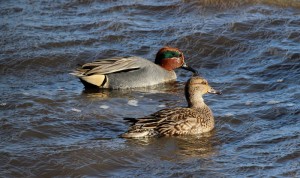 Now is the time to visit the coast to see the wealth of bird life such as waders, ducks and geese. As for access, locally we are spoilt for choice as there are two superb hides, both managed by the RSPB, at Udale Bay and Nigg Bay on the south and north shores, respectively, of the Cromarty Firth. There are many other suitable vantage points but one that is often overlooked is only a few miles east of Inverness at Alturlie Point. The main attraction is the various ducks and last weekend I went there to specifically try and see, and photograph, the tiny teal. As it turned out the tide was, I thought, all wrong as normally it is best when it is either making or ebbing about half way. Then the birds tend to feed on the freshly exposed mud or at the edge of the incoming tide. For my visit the tide was full, lapping up against the lower edge of the road but there was a bonus as it meant that many birds were close to the shore. There were many birds resting in the nearby fields and at one stage it was difficult to know just where to look as there was so much to see.
Now is the time to visit the coast to see the wealth of bird life such as waders, ducks and geese. As for access, locally we are spoilt for choice as there are two superb hides, both managed by the RSPB, at Udale Bay and Nigg Bay on the south and north shores, respectively, of the Cromarty Firth. There are many other suitable vantage points but one that is often overlooked is only a few miles east of Inverness at Alturlie Point. The main attraction is the various ducks and last weekend I went there to specifically try and see, and photograph, the tiny teal. As it turned out the tide was, I thought, all wrong as normally it is best when it is either making or ebbing about half way. Then the birds tend to feed on the freshly exposed mud or at the edge of the incoming tide. For my visit the tide was full, lapping up against the lower edge of the road but there was a bonus as it meant that many birds were close to the shore. There were many birds resting in the nearby fields and at one stage it was difficult to know just where to look as there was so much to see.
The biggest surprise was a black and white carrion crow in a field adjacent to the road as it met the shoreline. The bird had white feathers in both wings, although not symmetrical, and it was feeding with oystercatchers and curlews. The feeding birds looked like a peaceful scene with one or two coming in and others leaving. However, when the black and white crow took off pandemonium reigned as every other bird became agitated with some flying off. Obviously the odd black and white bird was something they did not understand. There was so much white on the crow that at first I thought it was a magpie. Some birds gave no reaction to the odd looking crow and they were the geese as they just carried on feeding. They were pink-footed geese and well over 300 of them so perhaps they were taking in food for their long journey north. They breed in Iceland and Greenland and the Iceland birds make the flight in a single journey without stopping.
The dominant birds were the ducks and they all seemed rather mixed with wigeon, teal, and mallard together although a few, about thirty, scaups were on their own further out on the open water. Some of the ducks were tamer than others and the wigeon and teal, in particular, were quite close to the shoreline with some of them actually out of the water. I used the car as a hide to avoid disturbing them and it seemed to work. With all of the ducks the adult males were much more colourful than the rather drab looking females. This is for two main reasons with one being that the brown barred plumage of the females is useful for camouflage. All the ducks nest on the ground and there are many predators from foxes to mink and crows to gulls so the ducks need the camouflage. In contrast, the plumage of the males, sometimes almost gaudy and flamboyant, is used in display. This may be courtship display to the females or aggression display to other males. This difference in the plumages was also the case with the teal and the male teal is, to my mind, one of the most attractive of ducks. As can be seen from the photograph the plumage is a delightful combination of a yellow flank contrasting with the chestnut head with its green eye patch.
Tags: highland wildlife
